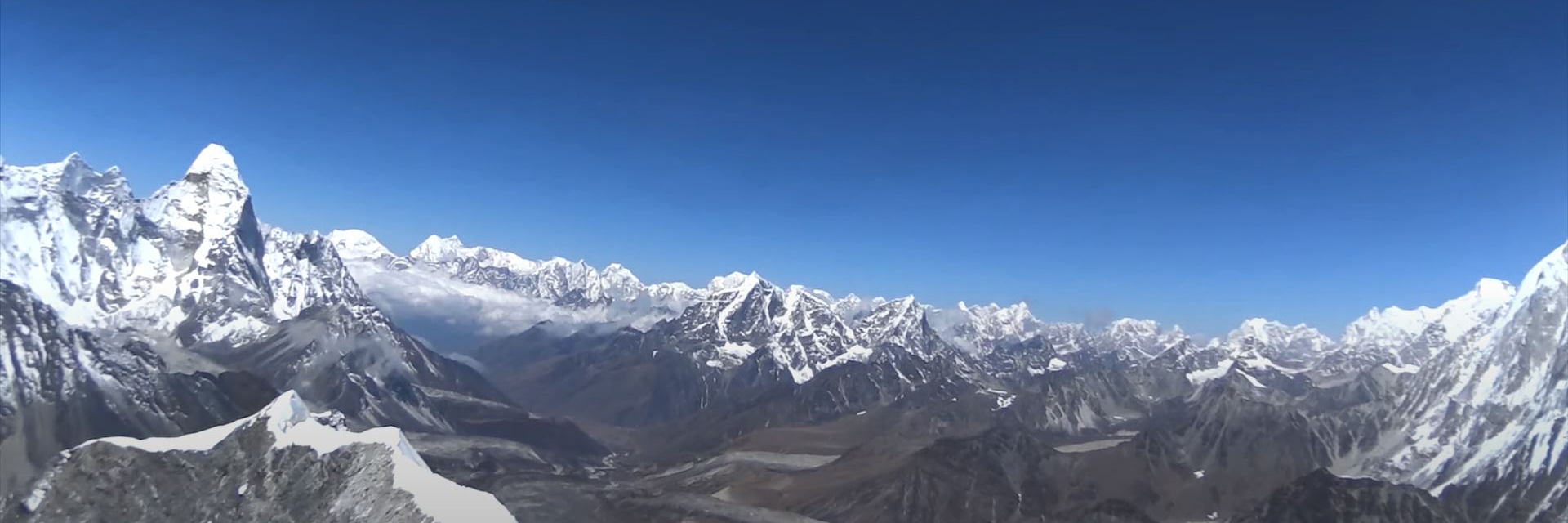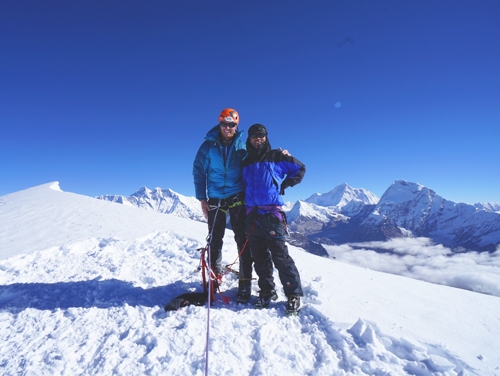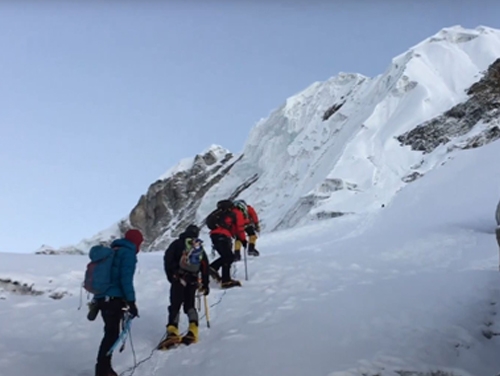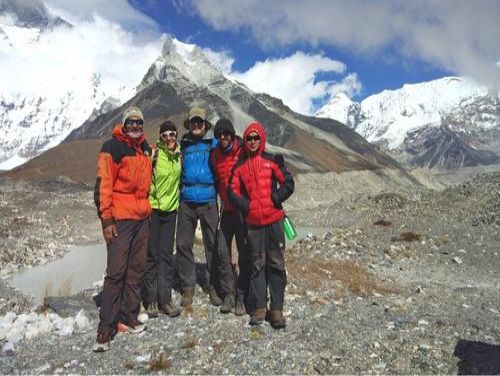Overview of Island Peak Climbing
The Everest region's Island Peak, locally known as Imja Tse, is one of Nepal's most adventurous mountain summits. It reaches a height of 6,189 meters (20,305 feet), perfect for adventure seekers.
The summit of Island Peak enables climbers to experience both trekking activities while learning mountaineering skills at a proper beginning level. The trekking journey starts off with a flight to Lukla. The trek will lead you to the stunning Namche Bazaar and Dingboche villages.
During your Island Peak Climbing, you can see green forest areas while passing through snowy mountain ranges and wild animals inside Sagarmatha National Park. Built-in rest intervals give you time to acclimatize to the high elevation.
Island Peak Climb is a thrilling adventure. With assistance from guides, you will walk snow-covered ground using ropes to overcome tiny ice barriers in your path.
The Island peak summit features amazing mountain views. You can spot Lhotse alongside Nuptse from the summit, with Ama Dablam nearby.
Island Peak Climbing gives an excellent mountain-climbing experience. While expert skills are not necessary, you must still try to remain fit. Local, experienced mountain guides and professional porters will assist you throughout your journey.
Climbing Island Peak leads to an unforgettable experience that combines natural beauty with cultural depth and personal accomplishment.
Island Peak Base Camp
Real adventures begin mainly at Island Peak Base Camp, which is located at an elevation of 5,200 meters (17,060 feet) and serves as the transition point from base camp to summit.
The Island Peak Expedition through local villages and elevated altitudes unlock stunning mountain views along with the peaceful atmosphere of the base camps.
The Island Peak Base Camp accommodation consists of tents where you will need time to acclimate yourself to the elevation. Base Camp offers a peaceful atmosphere where you can hear the wind blowing as fellow climbers occasionally converse with each other.
The base camp creates an opportunity for both relaxation and guide interaction alongside summit-focused mental preparation. Seeing the beautiful mountain views from this point lets you fully understand the Himalayas' natural beauty.
Things You Can Experience in Island Peak Climbing
Travellers exploring Island Peak climbing can visit Namche Bazaar and its beautiful scenic villages, blossoming forests, and taller snowy peaks. On the journey, you will pass through glaciers and ascend steep snow terrain while using ropes for protection.
Standing at the summit, you will have an amazing 360-degree panorama of Lhotse, Ama Dablam, and Nuptse, along with more snowy peaks.
Throughout the journey, you will stop at local tea houses to meet friendly Sherpa people and learn about their different cultural practices.
Panoramic Himalayan Views
A view from Island Peak shows several of the tallest mountains, including Lhotse, Ama Dablam, and Makalu. From the summit, you can see sparkling snow peaks reflecting sunlight. The height from which you stand reveals the beauty of the Himalayas around you.
High-Altitude Adventure
Finding your way to Summit Island Peak at 6,189 meters above sea level represents a thrilling, high-altitude adventure. While challenging, the journey remains secure with experienced guides to reach the summit, creating an incredible sense of accomplishment.
Trekking Through the Khumbu Region
The Khumbu region's hiking trail leads travellers to explore Namche Bazaar and Tengboche, along with other scenic villages. Through dense forests, you will see clean rivers flowing under blue skies, and snow-covered peaks will be visible throughout the route.
Walking through the Sherpa region, which has a welcoming culture, adds special joy to your exploration.
Cultural immersion
When you reach the heights, you will become familiar with Sherpa people who live a joyful life. Visitors can visit Buddhist monasteries along with praying through colorful flags and spinning prayer wheels.
Traditional Sherpa traditions together with their food and welcoming spirit create a lasting memory for all explorers.
Glacier and Ice Climbing
Large snowy glaciers serve as the base for Island Peak climbing operations. To maintain stability during icy areas along the glacier, you will need to use a rope system plus crampons.
Using guide-led assistance along with appropriate equipment enables you to experience the thrilling side of this climb without risk.
Physical and Mental Challenges
Your ability to breathe at these elevated altitudes will be challenged by the thin air while you simultaneously experience senseless fatigue.
The path to success requires a combination of mental drive and determination plus focused energy, which will carry you through obstacles.
Remote Camping and Lodging Experience
The journey to Summit Island Peak requires accommodations at cozy basic lodges and campsites throughout each stop. Small facilities with basic dining options are provided to tired trekkers after a tiring day on the trails.
Sunrise from the Summit
An amazing experience awaits the climbers on top of Island Peak to meet the rising sun. During sunrise, the mountains covered with snow show off their beauty as the Himalayan range emerges in full view before the sky.
Sunrise glows across the peaks to create peaceful moments that also bring pride to the climbers.
Preparation for Advanced Mountaineering
Practice walking on snowy and rocky land alongside fitness for attempting Island Peak ascent. Basic safety requires learning how to operate mountaineering tools, including ropes along with crampons and ice axes.
Adaptation to low air pressure at high altitudes can benefit climbers who aim to conquer this peak.
Explore Sagarmatha National Park
The region views the beautiful tallest peaks, which stand with dense forests while showcasing interesting wildlife populations. During a hiking expedition, you can spot both musk deer and Himalayan tahr while enjoying panoramic views of Mount Everest.
The park maintains a combination of settlements and Buddhist temples alongside multicoloured prayer flags.
Island Peak Climbing for Beginners
New climbers are offered the perfect opportunity at Island Peak to embark on their first Himalayan mountaineering experience. At 6,189 meters (20,305 feet), Island Peak stands as a difficult mountaineering ascent offering beautiful views of taller peaks.
People visiting Island Peak climbing must first take a flight to Lukla and then hike across Khumbu's scenic territories to reach Namche Bazaar and Pheriche villages.
The mountain climbers need to combine rope techniques with navigating snowy land while guided by experts through slippery areas. Climbing Island Peak provides an opportunity for new to learn mountaineering abilities involving crampons and ice axe techniques.
From the summit, you can see Everest, Lhotse, and Ama Dablam, along with various other mountain peaks surrounding the area.
Reaching this Himalayan peak delivers an everlasting travel experience where guests encounter extraordinary lands, cultural traditions and beautiful mountain views.
Preparation for Island Peak Climbing
To successfully climb Island Peak, one needs physical readiness combined with mental preparation and mounted learning in basic mountaineering abilities. Your climb will demand physical readiness with a focus on combined strength, endurance, and cardiovascular health to master treks and climb gradients at scale. Before your trip, you should walk in hilly areas while hiking at elevated altitudes to ensure your body accepts reduced atmospheric pressure more easily. Knowledge of how to use common mountaineering equipment, including ropes crampons and ice axes remains essential for successful climbing. Basic mountaineering courses enable you to master the necessary equipment and methods.
Your mental ability needs to be strong enough to handle variable conditions, high elevations, and fatigue. The climb requires both positive thinking and directed focus throughout. Professional guides will provide both support and essential safety measures throughout your climb. The equipment you need for a safe climbing experience includes safe gear combined with appropriate protective clothing and boots.
Island Peak Climbing Group Information
Climbing Island Peak, as part of a group, offers essential support alongside superior safety standards and increased entertainment value. The majority of climbers seeking this peak either hire experienced guides or join structured tour groups, particularly when starting out.
Seasoned climbing guides lead the routes to the best destinations while providing a complete safety presence that consists of essential climbing technology instructions and glacier and snow slope management knowledge.
The presence of others within a group will boost your motivation levels. As you climb with others, you discover people from various places, which enhances the social and fun components of the experience.
The entire climbing experience becomes easier when individuals join a group. Going with a guided climbing team allows you to enjoy your adventure while guides handle our gear book accommodations and prepare food for a safe and enjoyable climbing experience.
Successful Island Peak Climbers Per Year
Many climbers annually participate in the Nepalese mountain adventure which leads to Island Peak. Most climbers reach the Island Peak summit since the success rate is above 90%.
Guide experience, together with appropriate preparation strategies, leads to successful summit ascents. According to one company, a particular scheduling approach combined with additional acclimatization days and mountaineering training yields an 85% success rate.
Group size for Island Peak Climbing
Climbing Island Peak typically gathers 4 to 10 climbers within each expedition. Small groups receive priority because they enable guides to deliver enhanced personal support and maintain better control during climbing activities.
Your experience and safety during climbing will increase when you travel with fewer people. Organised expeditions featuring 10 to 20 climbers become challenging to control during complicated route sections yet offer multi-person expeditions through the climbing experience.
Your comfort level regarding pace, safety concerns, and social needs determines the appropriate group size. Guides maintain your safety and lead you to success regardless of group size. Professional porters can carry part of your gear, facilitating your climb.





